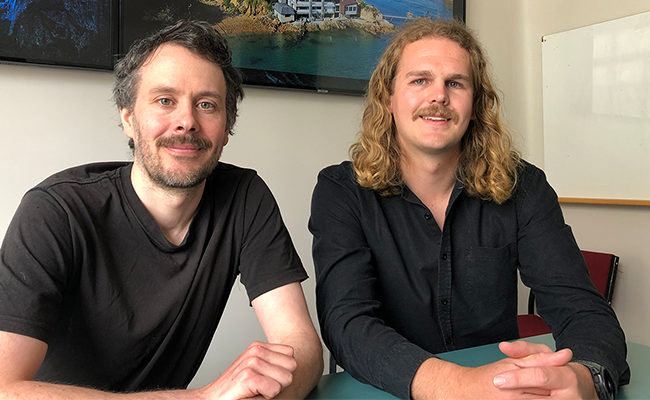
Dr Robert Smith, of the Department of Marine Science, left, with marine heatwave project lead researcher and PhD candidate Felix Cook.
An Australasian university collaboration has shed new light on marine heatwaves in New Zealand's coastal waters, utilising the two longest running daily in situ ocean temperature records in the Southern Hemisphere.
The research represents one of the few in-depth evaluations globally on marine heatwaves in nearshore ecosystems, such as rocky reefs, harbours and estuarine environments, and highlights the significant role of local atmospheric conditions in modulating the occurrence of extreme temperature events in these ocean ecosystems.
Lead researcher Felix Cook, a PhD student in the Department of Marine Science at the University of Otago, says this modulating role of local atmospheric conditions can cause temperature dynamics in these ecosystems to become decoupled from those in the nearby open-ocean environments.
“We found that marine heatwaves in nearshore coastal waters typically occur over timescales consistent with large-scale weather systems of 9-13 days, and that their onset is associated with a combination of factors that include blocking high pressure systems, low wind speeds and reduced heat loss to the atmosphere,” Mr Cook says.
The research also found a complex pattern of long-term trends in marine heatwave properties at two long-term coastal monitoring stations in the Otago Harbour in Ōtepoti/Dunedin and at Leigh north of Tāmaki Makaurau/Auckland.
The number of days per year that waters in the Otago Harbour experience marine heatwave conditions has doubled between 1967 and 2020, from around 19 to 40 days per year, while there was no evidence of an increase in exposure to marine heatwave conditions in coastal waters at Leigh over the same time period.
“This pattern is consistent with broad-scale warming trends previously documented at these two locations, with differences related to changes in large-scale ocean circulation patterns around New Zealand,” Mr Cook says.
The research, published today in Frontiers in Climate, is part of the Moana Project, a 5-year $11.5 million MBIE Endeavour ocean research initiative, which aims to improve understanding of coastal ocean circulation, larval connectivity and marine heatwaves to support sustainable growth of New Zealand's seafood sector.
The occurrence of marine heatwaves can have devastating effects on ecosystems, industry and communities Mr Cook explains, such as the summer 2021-22 event in the Marlborough Sounds that killed about 40 per cent of salmon across a series of aquaculture facilities, contributing to a $73 million loss for the company involved and the loss of 139 local jobs.
“Improving our understanding of the drivers of coastal marine heatwaves is supporting the development of forecasting tools in the Moana Project, which will provide our important ocean industries and coastal communities with more certainty and warning to prepare for the impacts of future marine heatwaves,” Mr Cook says.
The research was enabled through a collaboration between scientists based at the University of Otago, University of Auckland and University of New South Wales, and utilised measurements of ocean surface temperature that have been collected manually since 1953, from a pier at the Portobello Marine Laboratory in the Otago Harbour, and since 1967 around the Leigh Marine Laboratory north of Auckland.
Dr Robert Smith, one of Felix's supervisors and a Physical Oceanographer based in the Department of Marine Science, says long-term coastal records such as these are important for understanding climate variability and change.
“It's very hard to attribute change unless you have multi-decadal data records. These two data sets, which are maintained by scientists, professional staff and students at the University of Otago and University of Auckland, are globally significant as they represent the two longest continuous in-situ daily ocean temperature records in the Southern Hemisphere,” he says.
The data collected at the Portobello Marine Laboratory was automated in 2021 and both real-time and historical data from the new sensors is now freely available to researchers and the public via a University of Otago webpage.
“This has been an exciting recent development, as there's a lack of real-time ocean data available around New Zealand. Improving access to ocean data can help scientists, fishers, resource managers and the public to monitor and prepare for the impacts of these extreme temperature events.
“As climate change affects our oceans, marine heatwaves are expected to become more frequent, intense and longer lasting,” Dr Smith says.
“Our ocean life around New Zealand has evolved to thrive in cooler seas so the increasing incidence of marine heatwaves could have devastating effects on these sensitive nearshore ecosystems.”